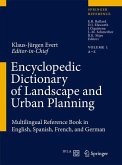This Frontis Publication is based on the workshop on "The New Dimensions of the European Landscape" that was held in Wageningen on 10-12 June 2002. The workshop was aiming to develop visions on the landscape in Europe, its development and design in the future and to strengthen the international network in landscape planning. This book contains the majority of the contributions; only a few have not been included due to various reasons.
The European Landscape is under stress of globalization, the disappearance of the iron curtain and the recent EU enlargement to 25 countries. The European landscapes as we know them now are facing huge changes. The rural and cultural heritage of Europe has to be adapted to the new situation, but it is also worth to be conserved as it represents the European history in the same way as castles and churches.
It cannot be avoided that Europe adapts to the new dimensions of the world. We, in Europe, have to define what we think is important, what must be conserved and what can be adapted to be used for new functions. In this workshop no final answers have been given, but the various aspects have been discussed and new roads are presented. One thing is agreed: education is needed to teach the urban dweller his or her rural past. That is the basis for the rural economy and the persistence of the cultural landscape.
The European Landscape is under stress of changing land use and a changing attitude of its users. Globalization, the disappearance of the iron curtain and the recent EU enlargement to 25 countries have changed the economic and environmental dimensions of Europe. Europe is changing its face from a western and eastern part to one European Union and to fast connections between its centres of activity. The rural and cultural heritage of Europe has to be adapted to cope with this change. However, its landscape is worth to be conserved as well, because it represents the European history in the same way as castles and churches. It even more represents the history of the common people, because it has been the tradition of the rural population that made these landscapes. It cannot be prevented that Europe is changing and it is good that Europe adapts to the new dimensions of the world. We, in Europe, have to define what we think is important and what must be conserved, what can be adaptedto be used for new functions and what can be abolished because it has no value. These decisions will determine the new dimensions of the European landscapes. The Frontis Workshop on the New Dimensions of the European Landscape was held on 10-12 June 2002. Wageningen University and Research Centre organized this workshop aiming to develop visions on the landscape in Europe, its development and design in the future and to strengthen the international network in landscape planning.
Hinweis: Dieser Artikel kann nur an eine deutsche Lieferadresse ausgeliefert werden.
The European Landscape is under stress of globalization, the disappearance of the iron curtain and the recent EU enlargement to 25 countries. The European landscapes as we know them now are facing huge changes. The rural and cultural heritage of Europe has to be adapted to the new situation, but it is also worth to be conserved as it represents the European history in the same way as castles and churches.
It cannot be avoided that Europe adapts to the new dimensions of the world. We, in Europe, have to define what we think is important, what must be conserved and what can be adapted to be used for new functions. In this workshop no final answers have been given, but the various aspects have been discussed and new roads are presented. One thing is agreed: education is needed to teach the urban dweller his or her rural past. That is the basis for the rural economy and the persistence of the cultural landscape.
The European Landscape is under stress of changing land use and a changing attitude of its users. Globalization, the disappearance of the iron curtain and the recent EU enlargement to 25 countries have changed the economic and environmental dimensions of Europe. Europe is changing its face from a western and eastern part to one European Union and to fast connections between its centres of activity. The rural and cultural heritage of Europe has to be adapted to cope with this change. However, its landscape is worth to be conserved as well, because it represents the European history in the same way as castles and churches. It even more represents the history of the common people, because it has been the tradition of the rural population that made these landscapes. It cannot be prevented that Europe is changing and it is good that Europe adapts to the new dimensions of the world. We, in Europe, have to define what we think is important and what must be conserved, what can be adaptedto be used for new functions and what can be abolished because it has no value. These decisions will determine the new dimensions of the European landscapes. The Frontis Workshop on the New Dimensions of the European Landscape was held on 10-12 June 2002. Wageningen University and Research Centre organized this workshop aiming to develop visions on the landscape in Europe, its development and design in the future and to strengthen the international network in landscape planning.
Hinweis: Dieser Artikel kann nur an eine deutsche Lieferadresse ausgeliefert werden.








